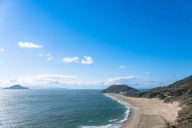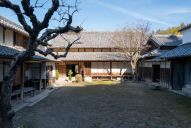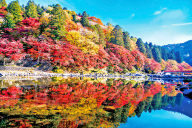|
|
|
|
|
|
| #23401 |
|
|
|
|
|
| HIMAKA Island |
a scenic gourmet resort island |
|
|

A resort island that can be reached from Nagoya in less than two hours by public transport. Its catchphrase is "The Island of Octopus and Pufferfish." Octopus can be enjoyed all year round. It takes about two hours to walk around the island at a leisurely pace. As it is a historic island with ancient tombs from the 7th and 8th centuries remaining, many places are known as power spots. There are many events to enjoy, such as festivals, fireworks, interacting with dolphins, clam digging, and fishing experiences. There are also many hotels, inns, and other accommodations. |
 |

Himaka, Minami-Chita town |
|
|
|
|
|
|
| #23101 |
|
|
|
|
|
| IRAGO Cape |
the cape where your love may come true |
|
 |

This ocean resort is located on a cape at the tip of the Atsumi Peninsula,
overlooking the Pacific Ocean, Ise Bay, and Mikawa Bay. The beautiful sandy
beach that stretches from the lighthouse on the cape is called Koijigahama
(Love Beach), and is extremely popular, especially with couples. |
 |

Irago town |
|
|
|
|
|
|
| #23201 |
|
|
|
|
|
| DASHI (Float) Festival |
a lavish and gorgeous traditional festival |
|
|
|

In Handa city, floats parade through town from each district from late March to early May. The Okkawa district festival, which leads the way in float events in the prefecture, is nicknamed the Fight Festival because of the violent way the floats are pulled up into the shrine, known as "Sakaage." Also, once every five years on the fourth Sunday and the day before, the Handa Float Festival is held, where 31 floats from 10 districts that still exist in Handa city gather together. The next one will be in 2027. |
 |

Handa city |
|
|
|
|
|
|
| #23202 |
|
|
|
|
|
| old residence of UCHIDA Family |
an old house belonging to a former shipping company |
 |

This is the mansion of the Uchida family, who were major shipowners of
Utsumi ships(The name refers to the area based in Utsumi (present-day Minamichita
Town) and its surrounding areas in the southern part of the Chita Peninsula)
and traders in the first half of the 19th century. It is designated as
an Important Cultural Property. The Utsumi ships' trading method was a
unique "buying and loading" method, whereby income was derived
not from freight charges for cargo, but from the profits from purchasing
goods in the production areas and selling them at the ports of call. At
their peak, 100 ships were in service. |
 |

Utsumi, Minami-Chita town |
|
|
|
|
|
|
| #23402 |
|
|
|
|
|
| HATCHO Miso (Soybean Paste) |
Traditional soybean miso made from soybean koji |
|
|

Hatcho miso is a long-aged soybean miso that originated in Hatcho-cho(town),
Okazaki City, Aichi Prefecture. Compared to other misos, it is characterized
by its high protein content. The history of Hatcho miso dates back to the
early Edo period. It is said that the health and longevity of Tokugawa
Ieyasu, the founder of the Edo period, was supported by "barley rice
and soybean miso." |
 |

Okazaki city |
|
|
|
|
|
|
| #23102 |
|
|
|
|
|
| KORANKEI Valley |
a valley with beautiful autumn foliage |
|
 |

Korankei is famous for its autumn leaves and dogtooth violets. It is said
to have started in 1634 when a local monk planted the trees, and now it
is one of the most popular spots in Japan for viewing autumn leaves, with
around 3,000 maple trees showing off their colorful colors. On the side
of the river, you can stroll through the old streets that evoke the past
as a post town. |
 |

Asuke town |
|
|
|
|
|
|
|
|
|
|
|
|
|
|
|
|
|
|
|
|
|
|
|
|
|
|
|
|